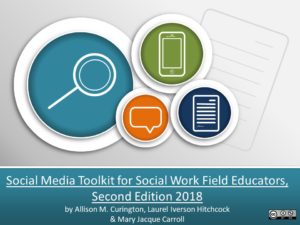Second Edition of the Social Media Toolkit for Social Work Field Educators
 We are pleased to announce the availability of the second edition of Social Media Toolkit for Social Work Field Educators (2018), which has been updated to address the recent changes to the Code of Ethics from the National Association of Social Workers.
We are pleased to announce the availability of the second edition of Social Media Toolkit for Social Work Field Educators (2018), which has been updated to address the recent changes to the Code of Ethics from the National Association of Social Workers.
This toolkit provides social work field educators with tools and resources to help social work students and field instructors assess, develop, and maintain an online identity for professional purposes. There are two parts to the toolkit – an Educator’s Guide and a PowerPoint Slide Deck. The Educator’s Guide provides directions, descriptions, and handouts related to the content of the toolkit while the Slide Deck includes pre-formatted slides with selected content for presenting in the classroom or a workshop. The content of this toolkit is divided into six different topics centered on how to use social media professionally as a social worker:
1. Ethical Considerations for Social Media Use in Social Work Practice
2. Reflecting on Social Media Use in Social Work Practice
3. Engaging and Self-Assessment with Social Media
4. Professional Practice with Social Media
5. Case Studies for Students & Field Educators
6. Social Media Learning Activities for Field Education
Specific content for these topic areas include learning activities about why, when, and how to use social media as a practicing social work professional; skills for managing an online identity; guidelines for developing one’s own professional social media policy; and case studies to help develop professional and ethical competency.
Teaching in the open: How I published a free textbook
Editor’s Note: Matthew DeCarlo is an assistant professor of social work in the School of Social Work at Radford University. In this blog post, he describes the concept of open teaching and how he adapted a research methods textbook for social work education.
What does it mean to teach in the open?
When I tell people I like to teach “in the open,” their first response is often “I already do that!” In way, they are right. To be an instructor is to be open and vulnerable by proclaiming yourself an expert (or at least a useful guide) and engaging students in the learning process. Students see through your eyes as you help them understand the social work knowledge base, and you are often faced with the limitations of your own knowledge.
In a different way, when I talk about teaching “in the open,” what I really mean is, “I want to share my educational resources with other educators and build on the resources that others have shared.” As a junior faculty member, I am constantly trying to figure out how best to teach new course content and improve my instruction. Faculty at both universities at which I have had the pleasure of teaching were open with me. Before beginning a new course preparation, at least two professors would happily meet with me so they can discuss their syllabi, review tips and tricks, and most importantly, share their materials. The message I received was, “take all of these materials, use whatever you want, don’t worry about giving me credit, and let me know if you have any questions.” Without these resources, junior faculty and adjuncts would be stuck reinventing the wheel—for instance, coming up with yet another prompt for an article presentation or slideshow on random sampling.
BPD Technology Committee’s Technology Assessment Checklist for Social Work Practice
Editor’s Note: This blog post was written by myself and my colleague, Dr. Nathalie P. Jones. We have been the co-chairs of the BPD Technology Committee for the past two-years (2017-2019) and served as editors for the Technology Assessment Checklist described and shared in this post.
In response to the growing influence of technology in the lives of individuals and families, the Technology Committee for the Association of Baccalaureate Social Work Program Directors (BPD) has created the Technology Assessment Checklist for Social Work Practice. This tool is designed to help social workers assess clients’ relationships and comfort with technology, including strengths, needs, risks, and challenges. This blog post describes the process used by the BPD Technology Committee to create this list as well as providing a description.
History of the BPD Technology Assessment Checklist
At the 2016 Annual Conference in Dallas, TX, the BPD Technology Committee embarked on a project to help create an assessment tool for social work practitioners and educators related to digital and social technologies. The goal was for the committee members, and others who were interested in the project, to work collaboratively to develop questions that could be used with individuals and families for the purposes of assessing clients’ use and relationships with digital and social technology. After the meeting, a call was put out on the BPD Listserv and a group of ten social workers agreed to assist with creating a technology-based assessment.
Using Mobile Apps with with Social Work Students
In this blog post, Steven Sturman, Instructional Designer at the University at Buffalo’s School of Social Work writes about how social work educators can incorporate mobile apps into the social work classroom.
Mobile apps put a wealth of information and resources at your fingertips for a variety of topics from bullying prevention to political engagement. They have the potential to be very useful in both social work education and practice. Integrating apps into student education provides students with a safe environment to experience mobile technology while they are learning about how to use an app, and how it might be implemented into a clinical setting. Additionally, they can experiment with what technology will and won’t work for them, and determining how the technology will fit in their professional development.
There are several things to consider when integrating apps into your classes, including how to pick the right apps, how to make sure the apps align well with your learning objectives, and how to make sure that your usage meets the NASW Standards for Technology in Social Work Practice. When considering the adoption of apps for educational purposes instructors must assess:




